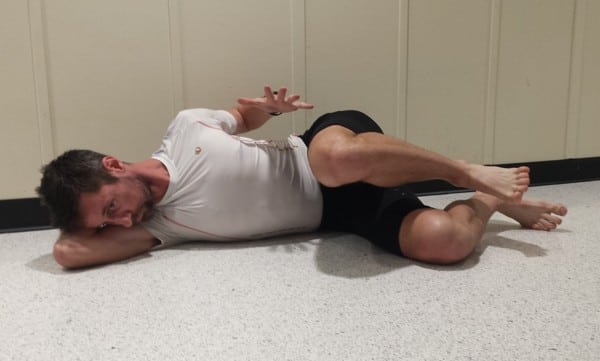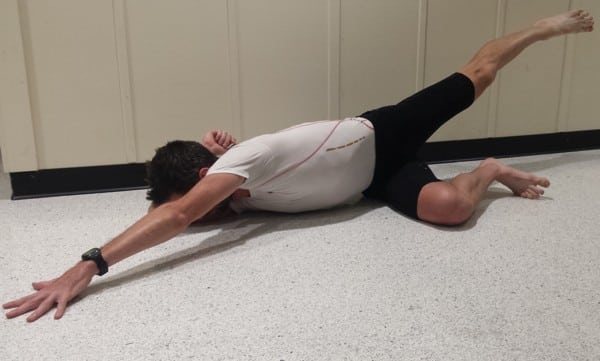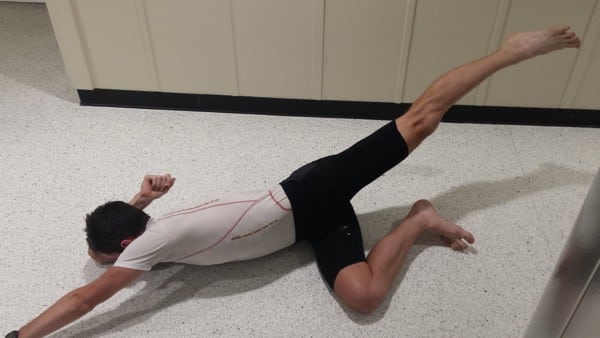 When I’m nearing the end of a treatment stint with a runner, knowing that folks seldom continue with the myriad prescribed physical-therapy exercises, I often proclaim, “If you pick only one exercise to keep doing, do this one!”
When I’m nearing the end of a treatment stint with a runner, knowing that folks seldom continue with the myriad prescribed physical-therapy exercises, I often proclaim, “If you pick only one exercise to keep doing, do this one!”
I then choose from among my favorite, multi-purpose exercises. The “Short and Long” exercise is one of them.
“Short and Long” is a term I use for the running pattern: a flexed, shortened driving leg, and an extended, lengthened push-off. While simple, it represents a whole-body movement pattern encompassing both the arm and leg as well as the trunk. The efficient pattern creates both maximum power and cushioning while running.
The Short and Long exercise is a way to practice the pattern slowly and methodically, providing both strengthening and stretching, and it also serves as a launching point for higher-level drills. As such, it’s a great addition to a runner’s stretching and strengthening routine!
The Exercise
The Short and Long is simple and straightforward. To begin, lie on your side with both hips flexed to a little bit less than 90 degrees and with the knees bent at an angle of just past 90 degrees, so that the feet are roughly below the knees.
The short action involves flexing the top knee slightly higher (to or above 90 degrees), and driving the top elbow behind, as if running:

The short action of the “Short and Long” exercise shown from the side. All photos: Sarah Lavender Smith

The short action shown from above.
Then, to lengthen, extended the leg straight, both at the hip and the knee, so that the leg is now beneath the pelvis and trunk. Simultaneously reach the arm overhead and forward, aiming to touch the ground roughly one to two feet in front of the body. The foot should be elevated at least six inches above the head to promote hip abduction action:

The long action of the “Short and Long” exercise as seen from the side.
Be Trail Strong and Stable!
The Short and Long is a fantastic multi-purpose running exercise to promote mobility and strength in the run stride, and it promotes maximum stability across all running surfaces. Throw it into your pre-run warm-up routine or as part of a post-run stretch or strengthening routine!

The long action as seen from above.
Make sure to emphasize maximal lengthening from the rib cage and pelvis, so as to stretch as long as possible. Also note the body slightly rotates, so the head is now facing the floor in the lengthened position.
The exercise can be held for as little as a few seconds to as long as a minute, depending on the stretch or strengthening effect you seek.
Short and Long Benefits
Strong Push-Off. The major strength benefit of the Short and Long is to accentuate push-off.
Extending the leg from the hip is is the driving force of running. The Short and Long practices this straight-beneath push-off so as to maximize hip extension, stretching hip flexors in front, without over-arching the low back.
Moreover, max-powered push-off is trunk and pelvis-driven: lengthening the trunk and pelvis adds significant power to the push-off phase. However, it can be difficult to conceptualize and feel what truly lengthened feels like. When performed in the side-lying position, the short and long makes it easier to practice that true lengthening:

Note the level of the pelvis (red line), which is elevated (“shortened”) in the flexed position.

In the lengthened position, the trunk and pelvis are so long that a space (blue circle) forms between the bottom side and the floor. This creates an extra two to four inches of leg extension, which translates to extra power and length in the running stride.
Stable Landing. Facilitating trunk and pelvis lengthening creates both an enhanced hip stability and cushioning with landing. Max stability and cushioning of the hips occur in this lengthened state, where the core muscles are used to maintain a strong, level pelvis–as opposed to a hip or pelvis that collapses upon landing. The Short and Long helps practices this “long and strong” position.
Elite Feet Action. During the Short and Long sequence, emphasize foot action. When lengthening, point the toes downward first. Then, to shorten, lead with the toes up. This helps maximize foot strength in the run pattern and promotes Elite Feet strength!
Hips of Steel. To perform as a true hip strengthener, consider adding a leg-cuff weight or resistance bands. The Short and Long can be done quickly and forcefully, and/or held for as long as a minute straight for max strengthening.
Trunk Mobility. The Short and Long is a wonderful trunk elongation and rotation stretch, specific for runners. Once in the lengthened and rotated state, allow the leg to come to rest on the ground for maximum hip and side-body stretch.

The downward-tilted red line indicates a lengthened trunk and pelvis position of the standing leg.
Launching Point for the 100-Up
The Short and Long is the same pattern employed in the 100-Up drill. Once mastered on the ground, take it to standing, and work on the compact flexion and extension pattern. But also work on your ability to get trunk and pelvic lengthening!
As described earlier, work toward a “long and strong” push-off and a soft, stable landing!
Short and Long Video
- What part of the running gait is your strongest, flexion or extension?
- And which of these parts of the running gait is your weak point? Do you feel like your hip flexors only weakly lift your knee or do you feel that your push-off could be stronger?
- When practicing the Short and Long, what is the easiest and hardest parts of the exercise for you?
